Arikara
Arikara (English: /əˈrɪkərə/), also known as Sahnish,[2] Arikaree or Hundi, are a tribe of Native Americans in North Dakota. Today, they are enrolled with the Mandan and the Hidatsa as the federally recognized tribe known as the Mandan, Hidatsa, and Arikara Nation.
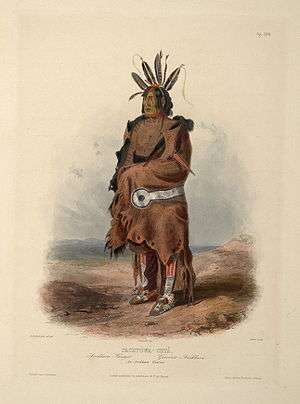 An Arikara warrior, ca. 1840–1843, by Karl Bodmer | |
| Total population | |
|---|---|
| 792 (2010 census)[1] | |
| Regions with significant populations | |
| Languages | |
| English, Arikara | |
| Religion | |
| Christianity, Native American Church | |
| Related ethnic groups | |
| Caddo, Kichai, Pawnee and Wichita |
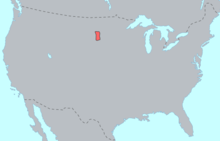
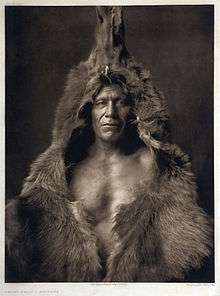
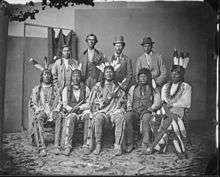
Synonymy
The Arikara's name is believed to mean "horns", in reference to the ancient custom of wearing two upright bones in their hair. The name also could mean "elk people" or "corn eaters".[3]
Language
The Arikara language is a member of the Caddoan language family. Arikara is close to the Pawnee language, but they are not mutually intelligible. As of 2007, the total number of remaining native speakers was reported as ten,[4] one of whom, Maude Starr, died on 20 January 2010.[5] She was a certified language teacher who participated in Arikara language education programs.[6]
Early history
Linguistic divergence between Arikara and Pawnee suggests a separation from the Skidi Pawnee in about the 15th century. The Arzberger Site near present-day Pierre, South Dakota, designated as a National Historic Landmark, is an archeological site from this period, containing the remains of a fortified village with more than 44 lodges.
An Arikara village, near where present-day Pierre, South Dakota developed, was visited in 1743 by two sons of the French trader and explorer La Vérendrye.[7]
In the last quarter of the 17th century, the Arikara came under attack from the Omaha/Ponca and the Iowa near the end of the Omaha/Ponca migration to Nebraska.[8] With peace established later, the Arikara influenced the newcomers. The Omaha still credit the Arikara women for instructing them in the art of building earth lodges.[9]
Culture and lifestyle
The Arikara lived as a semi-nomadic people on the Great Plains. During the sedentary seasons, the Arikara lived primarily in villages of earth lodges. While traveling or during the seasonal bison hunts, they erected portable tipis as temporary shelter. They were primarily an agricultural society, whose women cultivated varieties of corn (or maize). The crop was such an important staple of their society that it was referred to as "Mother Corn."[2]
An early European, a botanist, praised the Arikara women as excellent cultivators. He had not seen finer crops anywhere in America.[10] The surplus corn and other crops, along with tobacco, were traded to the Lakota, the Cheyenne and more southern plains tribes during short-lived truces. The amount of trading items passing through the Arikara villages made them a "trading center on the Upper Missouri".[11] Before smallpox epidemics hit the three village tribes, they were the "most influential and affluent peoples in the Northern Plains".[12]
Traditionally an Arikara family owned 30–40 dogs. The people used them for hunting and as sentries, but most importantly for transportation in the centuries before the Plains tribes adopted the use of horses in the 1600s. Many of the Plains tribes had used the travois, a lightweight transportation device pulled by dogs. It consisted of two long poles attached by a harness at the dog's shoulders, with the butt ends dragging behind the animal; midway, a ladder-like frame, or a hoop made of plaited thongs, was stretched between the poles; it held loads that might exceed 60 pounds. Women also used dogs to pull travois to haul firewood or infants. The travois were used to carry meat harvested during the seasonal hunts; a single dog could pull a quarter of a bison.[13]
The Arikara played a central role in the Great Plains Indian trading networks based on an advantageous geographical position combined with a surplus from agriculture and craft. Historical sources show that the Arikara villages were visited by Cree, Assiniboine, Crow, Cheyenne, Arapaho, Sioux, Kiowa, Plains Apache and Comanche.[14]
Mythology
The Arikara creation myth shows similarities with the creation myth of the neighboring Mandan people. It begins with the great sky chief Nishanu creating giants. The giants did not respect Nishanu who had created them and most of the giants were destroyed by a great flood. The good giants who were saved became corn kernels under the earth. Nishanu planted corn in the heavens yielding Mother Corn, who went to the earth to lead the people out of the East into the West, but after a time she returned to Heaven and in her absence the people of the earth began to kill one another. She returned to the earth with a leader who taught them how to fight their enemies rather than one another. This is an "emergence" style creation myth, depicting the "Corn Mother" as giving birth to the planted seeds (the remaining good giants after the flood). The figure of the "Corn Mother" can be found in many Native American mythologies. The myth is said to reflect the migrations of the Arikara from East to West.[15]
History up to 1850
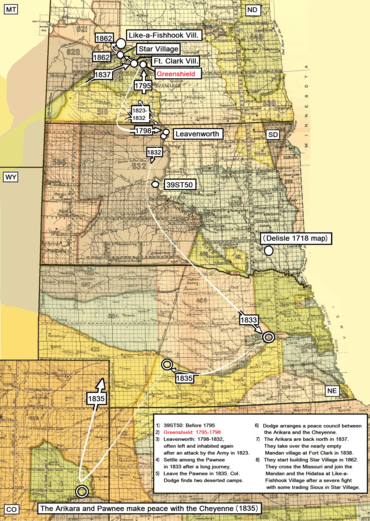
In the late 18th century, the tribe suffered a high rate of fatalities from smallpox epidemics, which reduced their population from an estimated 30,000 to 6,000, disrupting their social structure.[16]
The smallpox epidemic of 1780-1782 reduced the Arikara villages along the Missouri from 32 to 2.[17] The effects of the epidemic may have been so terrible that it could not be comprehended but in allegorical form.[18]
All-out war hit the weakened and often divided Arikara. In a burned-down village, (later studied as Larson Site), archaeologists found the mutilated skeletons of 71 men, women and children, killed in the early 1780s by unknown Indian attackers.[19] Groups of Sioux were the ones who gained most by the weakening of the Arikara. They attacked the vulnerable Arikara and increased "the pace of Sioux expansion" west of the Missouri.[20]
The Arikara faced many challenges during the first quarter of the 19th century: Reduced numbers, competition from white traders, and military pressure from the Lakota and other groups of Sioux. Alliances shifted constantly. The Arikara joined old foes the Sioux in raids on Mandan and Hidatsa Indians. Later they negotiated for peace with both village tribes.[21]
Due to their reduced numbers, the Arikara started to live closer to the Mandan and Hidatsa in the same area for mutual protection. They migrated gradually from present-day Nebraska and South Dakota into North Dakota. The remainder of the group was encountered in 1804 by the Lewis and Clark Expedition.[4]
The first Arikara delegation left for the capital, Washington, DC, in April 1805, urged by the Lewis and Clark Expedition. Chief Ankedoucharo became ill during his stay and died in Washington.[22] The delegates blamed the whites for the chief's death. That was one reason why the Arikara for the next decades were "notoriously hostile to white Americans".[23]
On June 2, 1823, the Arikara attacked a group of 70 trappers led by William Henry Ashley of the Henry/Ashley Company. The trappers were camped near an Arikara village at the mouth of Grand River (north of present-day Mobridge, South Dakota). Fourteen trappers died and 10 were wounded, including Hugh Glass, memorialized in the 1954 biographical novel "Lord Grizzly" by Frederick Manfred (see also The Revenant, which is loosely based on Hugh Glass).[24]
Colonel Henry Leavenworth left Fort Atkinson (now in Nebraska) with 220 men. More than 700 Yankton, Yanktonai and Lakota Indians joined him in the United States' first Indian war west of the Missouri. The Arikara retreated to their fortified village. Soon the disappointed Sioux left the battlefield. The Arikara escaped at night, and angry fur traders set their empty lodges ablaze the next morning.[25] "This was the only time in history that any of the Three Tribes fought in open warfare against the United States".[26]
The Bloody Hand and other Arikara chiefs signed a peace treaty with the United States (US) on July 18, 1825.[27] They may not have realized that under US terms, they at the same time recognized the supremacy of the United States.
In the winter/spring of 1833 members of the Arikara Tribe ambushed Hugh Glass, Hilain Menard and Colin Rose. "A hand-written notation made on the credit side of Menard's account book page states, 'Killed by the Rees near Fort Cass Spring 1833,'" Landry wrote in his article. "The word 'Rees' was mountaineer slang for the Arikara tribe." According to a letter written by John F. A. Sanford, an Indian agent, in a July 1833 letter to William Clark, superintendent of Indian Affairs. Landry includes the excerpt in his article."They scalped them and left part of the Scalps of each tied to poles on the grounds of the murder[.]"[24]
Years of indecision followed. The rootless Arikara lived near their southern "kinfolk," the Skidi Pawnee, for some years. They also tried their luck in hostile country far up on the Platte (now Nebraska), where Colonel Henry Dodge met them in 1835.[28] Harassed by the numerous Sioux, the Arikara finally buried old enmity and befriended the Mandan and the Hidatsa in the late 1830s. The manager in the trading post Fort Clark observed in June 1838, how "the Rees, Mandans and Gros Ventres [Hidatsas] started out early" in a common bison hunt.[29]
Smallpox had struck the Upper Missouri tribes the year before (and would again in 1856). It decimated the Mandan. The surviving Arikara took over the almost empty Mandan village Mitutanka next to Fort Clark.[30] The earth lodges stood until Yankton Sioux set them on fire in January 1839.[31] The village was rebuilt by the Arikara, who lived there until 1861. Another Sioux attack—and the need for a trading post—made them leave the settlement for good.[32]
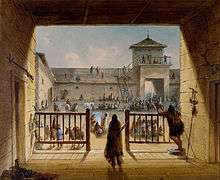
History up to 1900
.png)
The goal of the United States in the Laramie Treaty of 1851 was to establish a permanent peace on most of the northern plains and to define tribal territories. The basic treaty area of the Arikara, the Hidatsa and the Mandan was a mutual territory north of Heart River, encircled on the east and north by the Missouri and on the west by Yellowstone River down to the mouth of Powder River. The Lakota had continued to press north after 1823, so they got treaty rights on the area along Grand River as well as other land south of Heart River.[33]
Peace was short-lived. As drawings collected by W. J. Hoffman of Hunkpapa Chief Running Antelope showed, in 1853 he already had killed four Arikara Indians.[34] The next year the Three Tribes called for the U. S. Army to intervene; that request was repeated the next two decades.[35]
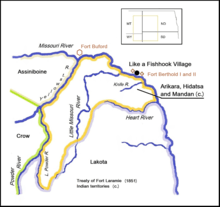
Arikara hunters were waylaid and had difficulties securing enough game and hides. A lengthy battle between an Arikara camp on hunt and several hundred Lakota took place in June 1858. The Arikara camp lost ten men, with 34 wounded.[36]
The Arikara built Star Village in the spring of 1862. They had to abandon it after a fierce fight with the Sioux a few months later. The Arikara crossed the Missouri and built new earth lodges and log houses near the common Mandan and Hidatsa village Like-a-Fishhook Village.[37] The village was built outside the Three Tribes treaty area. "We, the Arikara, have been driven from our country on the other side of the Missouri River by the Sioux", declared chief White Shield in 1864.[38]
Like a Fishhook Village was not safe from devastation, strikes or raids for horses (and neither was the nearby trading post Fort Berthold II). Just before the end of 1862, some Sioux burned a part of the village.[39] The affiliation of the Sioux is not always clear: Lakota, Yanktonai and "refugee" Santee Sioux from the Minnesota uprising sometimes attacked the Three Tribes.[40] As always in intertribal warfare, there were interludes with peace - and conflicts with other Indian foes, as for example the Assiniboine.[41]
In 1869, the Three Tribes asked the United States for guns as protection against hostile Sioux, and they finally received 300 pieces.[42]
The Three Tribes sold a part of their southern treaty land, more or less already annexed by the Lakota, to the United States on April 12, 1870. At the same time, they got treaty on the area where Like a Fishhook Village was located.[43][44]

In June 1874, Colonel George Armstrong Custer in Fort Abraham Lincoln (now North Dakota) received an order to delay his Black Hills Expedition and stop a large war party of Lakota on its way to attack Like a Fishhook Village. "The Rees and Mandans should be protected same as white settlers", read the order from General Phil Sheridan. Custer failed and the Lakota killed five Arikara and one Mandan.[46]
The Arikara "supplied some of the most faithful and effective Indian scouts" for the Army during the war against the bands of Lakota roaming other peoples' territories in 1876-1877.[47] "For tribes subject to Sioux pressure for decades, the combination of revenge and self-defense would constitute a powerful motivation" for joining the whites in actions like that.[48] Custer's favorite scout, an Arikara known as Bloody Knife, fell during the Battle of the Little Bighorn in the Crow Indian Reservation (now Montana) in 1876.[49]
"Mandans, Arickarees and Gros Ventres" were among the first Indian children to arrive at Hampton Institute, a historically black college, in Virginia for schooling, in 1878.[50]
The Fort Berthold Indian Reservation got a new shape and size by agreement in 1886 (ratified in 1891). In 1910, the Three Tribes gave their consent to sale of land, so the reservation was reduced once more.[51] The Arikara drifted away from Like a Fishhook Village. They raised and branded cattle instead of hunting buffalo.[52] With the Dawes Act and "allotment in severalty" passed as another attempt at assimilation to European-American culture, each Arikara family was allotted a homestead of 160 acres in the early 1890s. The Arikara Indians were considered citizens of the United States—and no more tribal village dwellers.[53]
During the Great Sioux War of 1876, some Arikara served as scouts for Custer in the Little Bighorn Campaign. The three tribes are settled on the Fort Berthold Indian Reservation in North Dakota.
See also
- Crow Creek massacre of 1325
- Mandan, Hidatsa, and Arikara Nation
- Arikara War
- Native American tribes in Nebraska
- List of Native American peoples in the United States
References
- "2010 Census CPH-T-6. American Indian and Alaska Native Tribes in the United States and Puerto Rico: 2010" (PDF). census.gov. Retrieved January 18, 2015.
- "History: The Sahnish (Arikara)." Mandan, Hidatsa, and Arikara Nation. (Retrieved Sep 29, 2011) Archived November 9, 2011, at the Wayback Machine
- Carl Waldman (September 2006). Encyclopedia of Native American tribes. Infobase Publishing. p. 26. ISBN 978-0-8160-6274-4. Retrieved November 22, 2011.
- SIL Ethnologue (18th ed., 2015)
- "Fluent Arikara speaker dies – KTIV NewsChannel 4 Sioux City IA: News, Weather and Sports". ktiv.com. Archived from the original on January 30, 2010. Retrieved January 28, 2010.
- "MHA Nation – Three Affiliated Tribes". mhanation.com. Archived from the original on June 14, 2011. Retrieved January 28, 2010.
- Meyer, Roy W. (1977). The Village Indians of the Upper Missouri. The Mandans, Hidatsas, and Arikaras. Lincoln and London. p. 24. ISBN 0-8032-0913-4.
- Ritter, Beth R. (2002). "Piecing Together the Ponca Past. Reconstructing Degiha Migration to the Great Plains". Great Plains Quarterly. 4 (22): 271–284, p. 276. JSTOR 23533249.
- Buffalohead, Eric (2004). "Dhegihan History: A Personal Journey". Plains Anthropologist. 49 (192): 327–343. p. 332. doi:10.1179/pan.2004.022.
- Bradbury, John (1966). Travels in the Interior of America in the Years 1809, 1810, and 1811. Ann Arbor. p. 165. ISBN 0-8032-6076-8.
- Ewers, John C. (1988). "The Indian Trade of the Upper Missouri before Lewis and Clark". Indian Life on the Upper Missouri. Norman and London. pp. 15–16. ISBN 0-8061-2141-6.
- Wood, Raymond W.; Thiessen, Thomas D. (1987). Early Fur Trade on the Northern Plains. Canadian Traders Among the Mandan and Hidatsa Indians, 1738–1818. Norman and London. p. 74, column II. ISBN 0-8061-1899-7.
- Fiedel, Stuart J. (2005). "Man's best friend – mammoth's worst enemy? A speculative essay on the role of dogs in Paleoindian colonization and megafaunal extinction". World Archaeology. 37 (1): 15–16. doi:10.1080/0043824042000329540.
- Swagerty, William R. (1988). "Indian Trade in the Trans-Mississippi West to 1870". Handbook of North American Indians, Volume 4: History of Indian White Relations. Smithsonian Institution. pp. 351–353. ISBN 0-16-080388-8.
- Leeming, David A. Creation Myths of the World. p. 50.
- "Lewis and Clark . Native Americans. Arikara Indians". pbs.org. Archived from the original on January 15, 2010. Retrieved January 28, 2010.
- Meyer, Roy Willard (1977). The village Indians of the upper Missouri: the Mandans, Hidatsas, and Arikaras. University of Nebraska Press. pp. 14 and 28. ISBN 0-8032-0913-4.
- Van De Logt, Mark (2015). "'The Whirlwind Is Coming to Destroy My People!': Symbolic Representations of Epidemics in Arikara Oral Tradition". The American Indian Quarterly. 39 (1).
- Calloway, Colin G. (2006). One Vast Winter Count: The Native American West Before Lewis and Clark. U of Nebraska Press. p. 310. ISBN 0-8032-6465-8.
- Hodge, Adam R. (October 2010). "Pestilence and Power: The Smallpox Epidemic of 1780-1782 and Intertribal Relations on the Northern Great Plains". The Historian. 72 (3): 559. doi:10.1111/j.1540-6563.2010.00270.x. PMID 21140933.
- Lutting, John C.: Journal of a Fur Trading Expedition on the Upper Missouri, 1812-1813. New York, 1964, pp. 80, 87, 110 and 113. McGinnis, Anthony: Counting Coup and Cutting Horses. Intertribal Warfare on the Northern Plains, 1738-1889. Evergreen, 1990, pp. 19-20.
- Meyer, Roy Willard (1977). The village Indians of the upper Missouri: the Mandans, Hidatsas, and Arikaras. University of Nebraska Press. p. 48. ISBN 0-8032-0913-4.
- Viola, Herman J.: Diplomats in Buckskins. A History of Indian Delegations in Washington City. Washington, D.C., 1981, p. 159.
- French, Brett. "Researcher sets record straight on famed mountain man Hugh Glass' death". The Billings Gazette. Retrieved December 27, 2016.
- Robinson, Doane: "Official Correspondence Pertaining to the Leavenworth Expedition into South Dakota in 1823 for the Conquest of the Ree Indians," South Dakota Historical Collections, Vol. 1 (1902), pp. 179-256.
- Meyer, Roy Willard (1977). The village Indians of the upper Missouri: the Mandans, Hidatsas, and Arikaras. University of Nebraska Press. p. 54. ISBN 0-8032-0913-4.
- Kappler, Charles J.: Indian Affairs. Laws and Treaties. Washington, 1904. Vol. 2, pp. 237-239.
- "Serial 289," 24th Congress, 1st Session, Vol. 4, House Document No. 181 p. 14.
- Chardon, F. A.: Chardon's Journal at Fort Clark, 1834-1839. (Edited by Annie Heloise Abel). Lincoln and London, 1997, p. 163.
- Dollar, Clyde D.: "The High Plains Smallpox Epidemic of 1837-38," Western Historical Quarterly, Vol. 8. No. 1, (January 1977), pp. 15-38. Collison, Patrick J.: "Bastions, Beads, Baptism, and Burials: Evidence for Epidemic Disease among the Arikara and their Ancestors," Plains Anthropologist, Vol. 58, No. 225, (2013), pp. 9-43, see p. 25.
- Chardon, F. A.: Chardon's Journal at Fort Clark, 1834-1839. (Edited by Annie Heloise Abel). Lincoln and London, 1997, p. 181.
- Meyer, Roy Willard (1977). The village Indians of the upper Missouri: the Mandans, Hidatsas, and Arikaras. University of Nebraska Press. pp. 108 and 285, note 76. ISBN 0-8032-0913-4.
- Kappler, Charles J.: Indian Affairs. Laws and Treaties. Washington, 1904. Vol. 2, p. 594.
- Mallery, Garrick: Picture-writing of the American Indians, 10th Annual Report of the Bureau of American Ethnology, 1888-89. Washington, D.C., 1893, pp. 572-573. For narratives of individual Lakota attacks on the Arikara, see e.g. Densmore, Francis: "Teton Sioux Music." Bureau of American Ethnology, Bulletin 61. Washington, 1918. For the later chief Red Cloud's experience with a war party against the Arikara, see: Paul, Eli R. (Ed.): Autobiography of Red Cloud. War Leader of the Oglalas. Helena, 1997, pp. 125-135.
- Meyer, Roy Willard (1977). The village Indians of the upper Missouri: the Mandans, Hidatsas, and Arikaras. University of Nebraska Press. p. 121. ISBN 0-8032-0913-4.
- Mattison, R. H.: "Henry A. Boller: Upper Missouri River Fur Trader," North Dakota History, Vol. 33, (1966), pp. 106-219, about the fight pp. 203-206.
- Meyer, Roy Willard (1977). The village Indians of the upper Missouri: the Mandans, Hidatsas, and Arikaras. University of Nebraska Press. p. 108. ISBN 0-8032-0913-4.
- Serial 1220, 38th Congress, 2nd Session, Vol. 5, House Executive Document No. 1, p. 408.
- Meyer, Roy Willard (1977). The village Indians of the upper Missouri: the Mandans, Hidatsas, and Arikaras. University of Nebraska Press. p. 119. ISBN 0-8032-0913-4.
- McGinnis, Anthony: Counting Coup and Cutting Horses. Intertribal Warfare on the Northern Plains, 1738-1889. Evergreen, 1990, p. 121.
- E.g. Boller, Henry A.: Among the Indians. Four Years on the Upper Missouri, 1858-1862. Lincoln, 1972, p. 154. McGinnis, Anthony: Counting Coup and Cutting Horses. Intertribal Warfare on the Northern Plains, 1738-1889. Evergreen, 1990, p. 102.
- McGinnis, Anthony: Counting Coup and Cutting Horses. Intertribal Warfare on the Northern Plains, 1738-1889. Evergreen, 1990, pp. 120-121.
- Meyer, Roy Willard (1977). The village Indians of the upper Missouri: the Mandans, Hidatsas, and Arikaras. University of Nebraska Press. p. map facing p. 112. ISBN 0-8032-0913-4.
- Also American Memory. (http://memory.loc.gov). Indian Land Cessions in the United States, 1784 to 1894. Serial 4015, 56th Congress, 1st Session, pp. 852-853. Map: Dakota 1.
- Custer, Elizabeth B.: "Boots and Saddles" or, Life in Dakota with Genera Custer. Norman, 1968, p. 275.
- McGinnis, Anthony: Counting Coups and Cutting Horses. Intertribal Warfare on the Northern Plains, 1738-1889. Evergreen, 1990, p. 133.
- Gray, john S.: "Arikara Scouts with Custer," North Dakota History, Vol. 35, (1968), pp. 442-478, quote p. 445.
- Dunlay, Thomas W.: Wolves for the Blue Soldiers. Indian Scouts and Auxiliaries with the United States Army, 1860-90. Lincoln and London, 1982, p. 112.
- Dunlay, Thomas W.: Wolves for the Blue Soldiers. Indian Scouts and Auxiliaries with the United States Army, 1860-1890. Lincoln and London, 1982, p. 54 and 113.
- Hultgren, Mary Lou and Paulette Fairbanks Molin: "Long Rides Across the Plains": Fort Berthold Students at Hampton Institute. North Dakota History, Vol. 61 (1994), No. 2, pp. 10-36.
- Meyer, Roy Willard (1977). The village Indians of the upper Missouri: the Mandans, Hidatsas, and Arikaras. University of Nebraska Press. pp. 136–137 and 163–164. ISBN 0-8032-0913-4.
- Gilman, Carolyn and Mary Jane Schneider: The Way to Independence. Memories of a Hidatsa Indian Family, 1840-1920. St. Paul, 1987, p. 242, column I.
- Meyer, Roy Willard (1977). The village Indians of the upper Missouri: the Mandans, Hidatsas, and Arikaras. University of Nebraska Press. p. 138 and 156. ISBN 0-8032-0913-4.
Bibliography
- Campbell, Lyle. (1997). American Indian languages: The Historical Linguistics of Native America, New York: Oxford University Press. ISBN 0-19-509427-1.
- Mithun, Marianne. (1999). The Languages of Native North America, Cambridge: Cambridge University Press. ISBN 0-521-23228-7 (hbk); ISBN 0-521-29875-X.
Further reading
- Gerald W. Wolff and Cash, Joseph H. Three Affiliated Tribes (1974), a study of the cultural relationships among the Arikara, Hidatsa, and Mandan. The book was the first published by the Institute of American Indian Studies at the University of South Dakota at Vermillion.
- "Institute of American Indian Studies, Overview: Our Future". usd.edu. Archived from the original on November 10, 2010. Retrieved November 14, 2010.
External links
| Wikimedia Commons has media related to Arikara. |